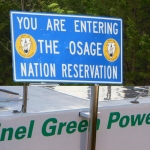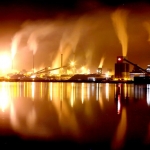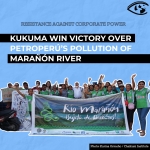PERU: Leaky Gas Pipeline Finds Foes in Washington
Phase II of Peru's controversial Camisea gas project has once again run up against opposition from the U.S. government and Senate, which may vote against approving additional Inter-American Development Bank (IDB) funding.
Wednesday's U.S. Senate Foreign Relations Committee public hearing, under Senator Richard Lugar, boded ill for the megaproject's second-phase investors.
Testifying before the Committee, Assistant Secretary for International Affairs Clay Lowery criticised the project's negative impacts on the Peruvian Amazon environment and indigenous communities.
During the session, which Lugar convened to hear evidence on problematic energy projects involving U.S.-based investments, Lowery's comments poured cold water on the expectations of companies involved in Camisea 2.
The initial phase of the project, a 720-kilometre gas pipeline running from deposits in the southern region of Cuzco to the Pacific Coast, has been plagued by leaks and ruptures -- five in fewer than two years.
After criticising Camisea's social and environmental impacts, Lowery said Washington had not yet decided how it will vote on the 400-million-dollar loan the consortium has requested from the IBD to install a liquefaction plant and a pier for gas exports in Cañete, south of Lima.
The Peruvian LGN consortium includes U.S.-based Hunt Oil, the Spanish-Argentine Repsol YPF company, Algeria's Sonatrach, Korea's SK Corporation and Argentina's Pluspetrol, among others, which have invested an estimated 720 million dollars in the Camisea II project.
Invited to the hearing were two of Peru's former Energy and Mines ministers: Carlos Herrera Descalzi, a Camisea expert, and representative for Peru and five other countries as executive director at the Board of the World Bank, and Jaime QuijandrÃa, who was also economy minister in the outgoing Alejandro Toledo administration.
Herrera Descalzi told IPS that Lowery "diplomatically hinted that the United States would not back the loan for Camisea II; if his country was willing to approve the credit request, Lowery would have said as much."
In his presentation, Herrera Descalzi noted that Peru's government did little to ensure that the Camisea consortium would implement measures to minimise the pipeline's damage to indigenous communities and the environment.
He also said that, to date, cheaper electricity rates -- promised as a benefit of massive consumption of Camisea's natural gas -- have not materialised. "One out of four people in Peru is not getting electricity and the promise of Camisea to deliver services to the poor has not been met."
Furthermore, added Herrera Descalzi, the Peruvian government was unable to collect heavy fines for the pipeline ruptures, even though the company was found responsible.
QuijandrÃa, who once worked for the Peruvian affiliate of Argentina's former YPF oil company, testified before the Senate committee that the first phase of the 1.6-billion-dollar Camisea project affected the jungle indigenous communities and environment near the operations centre.
"The Camisea project had negative impacts on the people who live in the region," he said, according to a copy of his presentation. "In particular, the indigenous people who live near the gas production facilities have been affected the most."
QuijandrÃa stated that damage to jungle dwellers could be traced back to the early days of the deposit exploitation. "The impact is even worse since some of these indigenous populations had had no contact with the outside world until the project started," he said.
The former minister referred to the recommendations in the ombudsman's report, which last March delivered harsh criticism to Camisea investors for violating the most basic human rights of local indigenous communities, in the wake of reports describing the introduction of disease, and toxic waste dumping.
But all of these are "lessons learned" that could mitigate the negative impacts of Phase 2, argued QuijandrÃa.
His argument may have been convincing enough to sway Washington towards approval of the pending loan application.
QuijandrÃa vowed that even if the United States, perhaps under pressure from non-governmental environmental groups, blocked the IDB loan, investors are prepared to find other funding sources to ensure that the Camisea II project goes ahead.
Lowery also criticised the IBD for handling loans according to strictly financial criteria, when it should be ensuring that funds will be used in projects free of collateral damage.
In September 2003, the IDB approved a 74-million-dollar loan for Camisea I, but imposed environmental and social requirements that, according to Lowery, were all but toothless.
The project model was fundamentally flawed, he charged. It wasn't until this year -- after the fifth pipeline leak -- that the IBD conducted two in-depth audits on the Camisea project -- one examining infrastructure, another scrutinising social and environmental aspects.
Lugar raised his concern over the Toledo administration's decision to channel a portion of gas royalties to a new National Defence Fund to purchase weapons.
Between 2005 and 2025, this fund will provide 2.25 billion dollars to modernise Peru's Armed Forces equipment.
"Senator Lugar questioned why Camisea gas revenue would be used to purchase weapons when the project was implemented to promote development," Herrera Descalzi told IPS. "It was a very uncomfortable moment -- on the level of when they brought up the five gas leaks."
The hearing was held three weeks after a Peruvian Congressional Investigative Commission released a report on the causes of the Camisea pipeline ruptures.
Headed by Congressman Carlos Armas Vela, the commission concluded that the Toledo administration rushed Transportadora de Gas del Perú (TGP) consortium to in the laying of the pipe, according to a copy of the report obtained by IPS.
But the commission also faulted TGP for negligently bowing to government pressure and failing to prevent potential infrastructure damage resulting from the slapdash manner in which the project was completed.
The investigative commission called for a review of the contract between the Peru and TGP, to include provisions for heavy fines in the event negative social and environmental impacts are not resolved.
TGP representatives, speaking with IPS, denied that the government pressured the company, "because the timeframes were agreed when the contract was ratified under the ValentÃn Paniagua administration, not under Alejandro Toledo."
In terms of the contract revision, TGP representatives did not discard the possibility that both parties may sit down to adjust some aspects, but also emphasised that the agreement is valid for 30 years, during which time the investments are protected.
"The U.S. government considers the Camisea project a failure," Herrera Descalzi told IPS.
"Assistant Secretary Lowery was not referring to the economic aspect, but rather social and environmental considerations. The concerns are well known, and include not only the damage to indigenous communities and the environment, but also the financing difficulties the Peruvian State has faced in such an important development project."
- 107 Energy



